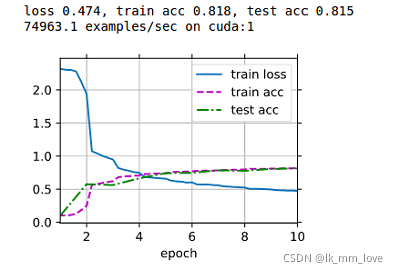????????LeNet作为现在各种卷积神经网络的始祖,其网络结构虽然只有7层,却包含了卷积神经网络的基本组件,具体关于LeNet详解请参考:????????LeNet详解_Charles的博客-CSDN博客_lenet
? ? ? ? 今天我们来实现如何不需要调参就可以提高LeNet在数据集fashion-mnist上的训练精度和测试精度。
????????所用代码为李沐所编写的《动手学深度学习》《动手学深度学习》 — 动手学深度学习 2.0.0-alpha2 documentation
所需要深度学习框架为torch,使用GPU训练
包为d2l 安装方法为:
pip install d2l????????我们实例化一个Sequential块,并将所需要的成连接在一起,将原始模型做了一些改动,去掉了最后一层的高斯激活。
import torch
from torch import nn
from d2l import torch as d2l
class Reshape(torch.nn.Module):
def forward(self, x):
return x.view(-1, 1, 28, 28)
net = torch.nn.Sequential(
Reshape(),
nn.Conv2d(1, 6, kernel_size=5, padding=2), nn.Sigmoid(),
nn.AvgPool2d(kernel_size=2, stride=2),
nn.Conv2d(6, 16, kernel_size=5), nn.Sigmoid(),
nn.AvgPool2d(kernel_size=2, stride=2),
nn.Flatten(),
nn.Linear(16 * 5 * 5, 120), nn.Sigmoid(),
nn.Linear(120, 84), nn.Sigmoid(),
nn.Linear(84, 10))接下来,输入一个28*28的单通道图像,打印在没一层的输出形状来检查模型。
X = torch.rand(size=(1, 1, 28, 28), dtype=torch.float32)
for layer in net:
X = layer(X)
print(layer.__class__.__name__,'output shape: \t',X.shape)输出如下:
Reshape output shape: torch.Size([1, 1, 28, 28]) Conv2d output shape: torch.Size([1, 6, 28, 28]) Sigmoid output shape: torch.Size([1, 6, 28, 28]) AvgPool2d output shape: torch.Size([1, 6, 14, 14]) Conv2d output shape: torch.Size([1, 16, 10, 10]) Sigmoid output shape: torch.Size([1, 16, 10, 10]) AvgPool2d output shape: torch.Size([1, 16, 5, 5]) Flatten output shape: torch.Size([1, 400]) Linear output shape: torch.Size([1, 120]) Sigmoid output shape: torch.Size([1, 120]) Linear output shape: torch.Size([1, 84]) Sigmoid output shape: torch.Size([1, 84]) Linear output shape: torch.Size([1, 10])
????????通过检查打印出的每层输出,判断模型没有问题接下来进行模型训练,首先我们需要设置batch_size,下载数据集Fashion-MNIST。
batch_size = 256
train_iter, test_iter = d2l.load_data_fashion_mnist(batch_size=batch_size)????????接下来设置使用GPU来进行训练,train_ch6()为d2l包中内置函数,具体查看《动手学深度学习》6.6节。
#@save
def train_ch6(net, train_iter, test_iter, num_epochs, lr, device):
"""用GPU训练模型(书中在第六章定义)。"""
def init_weights(m):
if type(m) == nn.Linear or type(m) == nn.Conv2d:
nn.init.xavier_uniform_(m.weight)
net.apply(init_weights)
print('training on', device)
net.to(device)
optimizer = torch.optim.SGD(net.parameters(), lr=lr)
loss = nn.CrossEntropyLoss()
animator = d2l.Animator(xlabel='epoch', xlim=[1, num_epochs],
legend=['train loss', 'train acc', 'test acc'])
timer, num_batches = d2l.Timer(), len(train_iter)
for epoch in range(num_epochs):
# 训练损失之和,训练准确率之和,范例数
metric = d2l.Accumulator(3)
net.train()
for i, (X, y) in enumerate(train_iter):
timer.start()
optimizer.zero_grad()
X, y = X.to(device), y.to(device)
y_hat = net(X)
l = loss(y_hat, y)
l.backward()
optimizer.step()
with torch.no_grad():
metric.add(l * X.shape[0], d2l.accuracy(y_hat, y), X.shape[0])
timer.stop()
train_l = metric[0] / metric[2]
train_acc = metric[1] / metric[2]
if (i + 1) % (num_batches // 5) == 0 or i == num_batches - 1:
animator.add(epoch + (i + 1) / num_batches,
(train_l, train_acc, None))
test_acc = evaluate_accuracy_gpu(net, test_iter)
animator.add(epoch + 1, (None, None, test_acc))
print(f'loss {train_l:.3f}, train acc {train_acc:.3f}, '
f'test acc {test_acc:.3f}')
print(f'{metric[2] * num_epochs / timer.sum():.1f} examples/sec '
f'on {str(device)}')设置学习率,迭代次数
lr, num_epochs = 0.9, 10
train_ch6(net, train_iter, test_iter, num_epochs, lr, d2l.try_gpu())开始训练,结果如下:

?